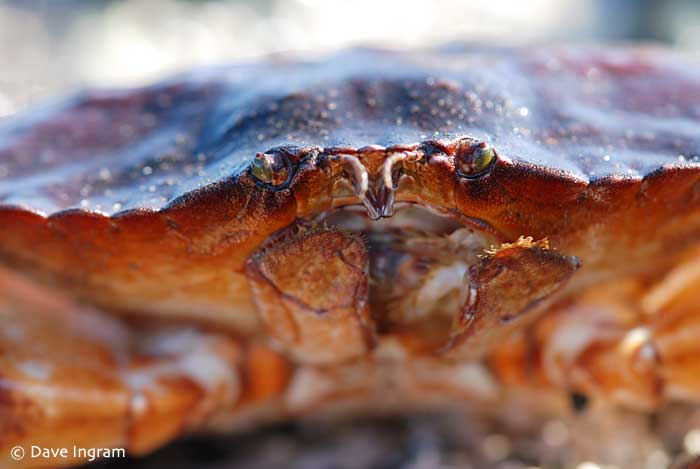I headed out to Point Holmes this afternoon to look for and photograph a selection of beach rocks. As with all trips to the shore of the sea, it is very easy for a naturalist to get pleasantly off track. I was a little overwhelmed looking for something a little different from the ubiquitous granites and basalts that make up the pebbles on this part of Vancouver Island when I noticed that the tide was still going out and a cobblestone bar was now accessible. Having learned my lesson at the Filberg mudflats, I was appropriately prepared to do some tide-pool exploring! This time I waded through the shallow water in my rubber boots.
Red Rock Crabs
It was then that I noticed the Red Rock Crabs (Cancer productus). Some were digging into the sand and underneath rocks as the water level dropped while others were making their way to deeper water on either side of the narrow bar that was emerging. It was a perfect opportunity to photograph these crabs since they hadn’t quite settled into their hiding places to wait out the low tide. It was interesting to see so many (at least a half dozen) at this time of day since they are generally more active at night.
Identifying Features
Red Rock Crabs are a distinctive crab and easy to identify. Like the name suggests, this crab is a brick red in colour. The tips of the pincers are black and the “teeth” bordering the edge of its carapace are round. These differences serve to separate the Red Rock Crab from the Dungeness Crab (Cancer magister). The latter is generally a sandy gray/brown and lacks the black tipped pincers. The “teeth” bordering the edge of the Dungeness’ shell are sharp. I remember this feature by reminding myself that sharp items are likely in a “dungeon.” Dungeness Crabs tend to grow to a larger size, up to 28 cm across the carapace compared to up to 20 cm across for the Red Rock Crab.
Food Sources
An aggressive carnivore, Red Rock Crabs feed on barnacles, mussels, clams, snails, and smaller crabs. While usually not harvested commercially due to their small size and hard shell (the Dungeness is preferred), they are sometimes collected by recreational harvesters, especially in areas where the Dungeness has been over collected. Rockfish, octopus and marine mammals also eat Red Rock Crabs.
I managed a close look at the pincers while the crab was in a defensive position with its claws raised above its body. Several field books warn to be wary of the pincers since they are strong enough to crack clam shells. I decided not to test this theory!
I left the crabs to their important task of finding shelter and wandered out onto the cobblestone to look for more interesting things to discover. It seemed like the perfect way to start an hour or so of beach exploration.




